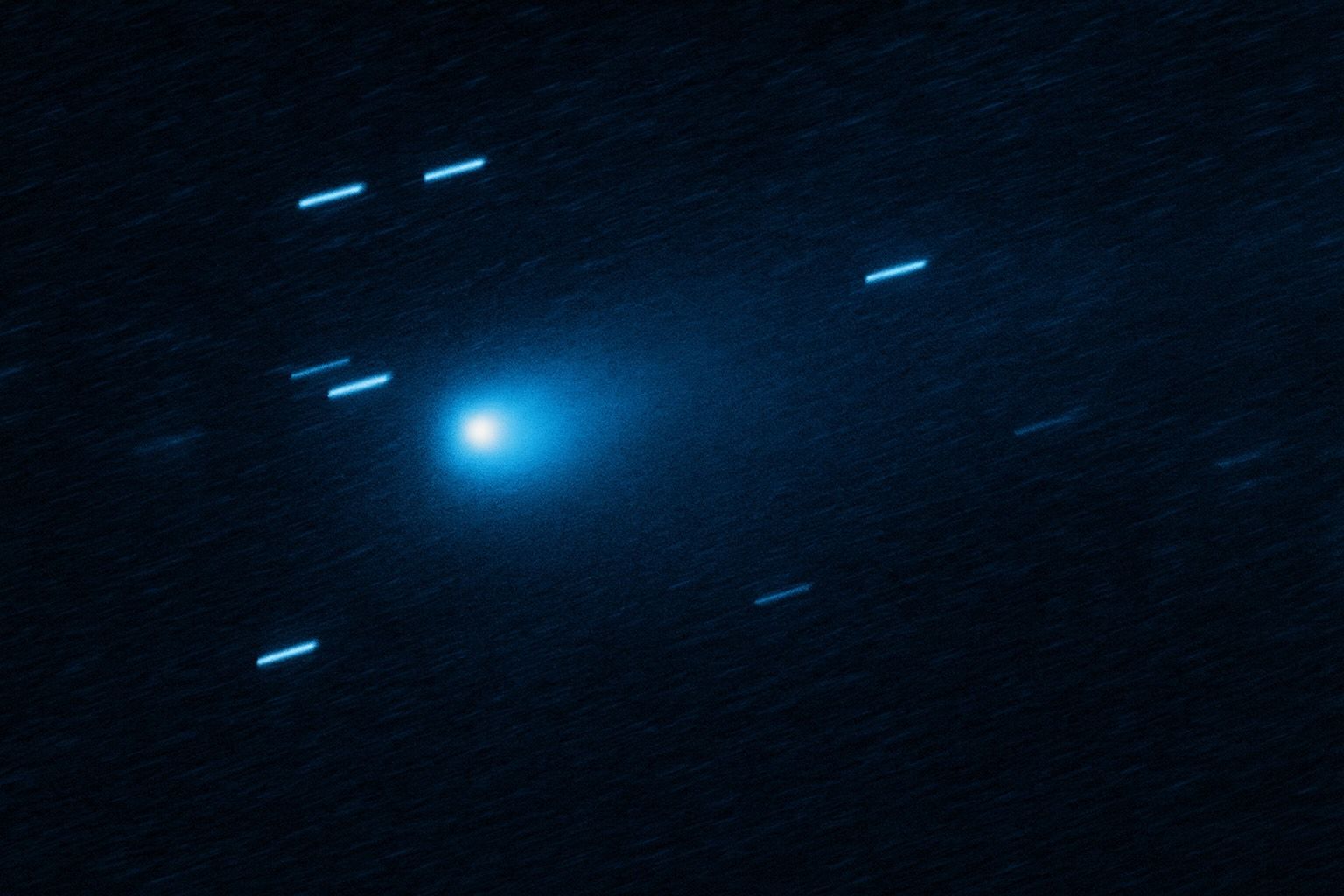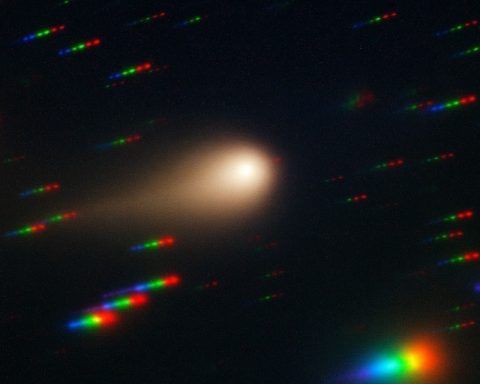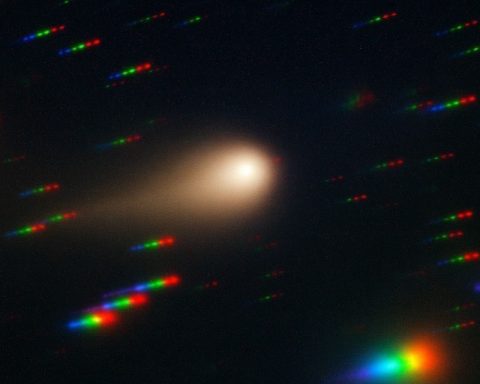- Third Interstellar Visitor: 3I/ATLAS (also designated 3I/2025 A1) was discovered on July 1, 2025 by the ATLAS sky survey in Chile [1]. Its orbit is strongly hyperbolic (eccentricity ≈6.14), confirming it came from outside our Solar System – only the third such object after ‘Oumuamua and 2I/Borisov [2] [3]. NASA calls it a “third known object from outside our solar system” [4].
- Ancient “Time Capsule”: Trajectory analysis suggests 3I/ATLAS formed very early in the galaxy – perhaps 7–10 billion years ago [5] [6]. Astronomers estimate it may be ~3 billion years older than our 4.6-billion-year Solar System [7] [8]. In short, it is a frozen relic of a long-dead planetary system.
- Huge, Carbon-Rich Nucleus: Observations indicate a large nucleus (roughly 2–6 km across) and enormous mass (on the order of tens of billions of tons) [9] [10]. Spectroscopy (JWST, SPHEREx, Hubble, etc.) shows 3I/ATLAS is rich in carbon dioxide and water ice but very low in carbon monoxide [11] [12]. Its CO₂-to-H₂O ratio is extreme (~8:1) [13], implying it formed in a carbon-rich environment or was “well baked” (driving off CO) before being ejected from its home system [14] [15].
- Active Comet Far from Sun: Unusually for an interstellar visitor, 3I/ATLAS is very “comet-like” – bright, active, with a fuzzy coma and tail [16] [17]. In fact, NASA’s Swift space telescope detected the ultraviolet glow of hydroxyl (OH) from 3I/ATLAS at ~3 astronomical units from the Sun [18] [19]. This indicates water vapor is being released at about 40 kg/s (roughly the output of a fire hose) even at that large distance [20] [21].
- Captured by Mars Orbiters: On Oct 3, 2025, 3I/ATLAS flew within ~30 million km of Mars. ESA’s orbiters (Mars Express and the ExoMars Trace Gas Orbiter) imaged the tiny, dim object [22] [23]. The comet was extremely faint – “around 10,000 to 100,000 times fainter than our usual target,” noted Dr. Nick Thomas (CaSSIS camera lead) [24] [25] – making the detection a major technical feat.
- No Threat (and No Aliens): All evidence shows 3I/ATLAS is a natural comet, not an alien probe. Its closest approach to Earth will be ~1.8 AU (over 270 million km) [26] [27]. NASA and ESA emphasize its trajectory is a “benign flight path” with “zero danger” to Earth [28] [29]. ESA scientist Dr. Michael Küppers stresses it “looks like a comet and it behaves like a comet” with no signs of technology [30].
These astounding discoveries come from coordinated observations worldwide. Below we delve into the details: what we’ve learned about 3I/ATLAS, how it compares to other interstellar visitors, and why scientists are so excited.
What Is 3I/ATLAS? A Rare Interstellar Comet
3I/ATLAS (sometimes simply called “ATLAS”) is an interstellar comet – a chunk of ice and rock that formed around a distant star and is now speeding through our Solar System on a one-way trip. It was first spotted on July 1, 2025, by the Asteroid Terrestrial-impact Last Alert System (ATLAS) telescope in Chile [31]. Follow-up analyses quickly confirmed its hyperbolic orbit and high speed (~210,000 km/h) [32], which showed it is not bound to the Sun and will never return. The Minor Planet Center officially designated it the third interstellar object ever found [33], after ‘Oumuamua in 2017 and Comet Borisov in 2019.
According to NASA, “when the orbit of 3I/ATLAS is traced into the past, the comet clearly originates from outside our solar system” [34]. Its discovery was surprising: as one science writer quipped, “you wait ages for an interstellar comet to arrive and then three come along at once” [35]. In contrast to the previous two, 3I/ATLAS is the most “comet-like” so far. ‘Oumuamua appeared as a dry, rocky asteroid, and Borisov was active but stayed far from the Sun. 3I/ATLAS, however, is large, bright, and actively outgassing gas and dust as it nears the Sun [36] [37]. ESA’s Michael Küppers comments that these interstellar objects are “the first building blocks we can observe from [other stellar] systems… They tell us about the conditions in the stellar system where they formed” [38].
Astrophysical models suggest 3I/ATLAS formed billions of years ago in a distant system. Its orbit indicates it entered the Solar System from the direction of Sagittarius, roughly in the plane of the planets [39]. Based on its trajectory and unusual chemistry, astronomers estimate its formation age may be on the order of 7–10 billion years – meaning it condensed in a nascent planetary disk long before Earth existed [40] [41]. In fact, Space.com reports “astronomers think it’s the oldest comet ever observed, with a birth that predates that of our own solar system by perhaps three billion years” [42]. In short, 3I/ATLAS is a cosmic time capsule carrying primordial material from an alien world.
A Carbon-Rich “Super-Comet”
Telescopic and spacecraft measurements show 3I/ATLAS to be unusually large and massive for a comet. By analyzing the coma and tail in Hubble images, astronomers constrained its nucleus to be on the order of a few kilometers across (estimates range up to ~5–6 km) [43] [44]. Even at the lower end, it is far bigger than ‘Oumuamua (≲0.4 km) or Borisov (~1 km) [45] [46]. Its mass is also enormous – on the order of 3×10^10 tons (tens of billions of tons) [47] [48], comparable to a small mountain on Earth. One study notes this is “far larger than the previous two interstellar visitors” [49].
Spectroscopy from JWST, NASA’s new SPHEREx telescope, and other instruments has revealed a startling composition. The coma (thin atmosphere) of 3I/ATLAS is enveloped in a fog of carbon dioxide gas extending hundreds of thousands of kilometers [50]. In fact, SPHEREx detected CO₂ out to ~348,000 km from the nucleus [51]. Water ice signatures are also present, but carbon monoxide (CO) is conspicuously scarce. This gives 3I/ATLAS a CO₂-to-H₂O ratio of roughly 8:1 – among the highest ever seen in a comet [52]. Johns Hopkins scientist Carey Lisse remarks that such a high CO₂/H₂O ratio “suggests 3I/ATLAS was well baked and boiled” in its home system before ejection [53] [54]. In other words, it likely formed in a warm, carbon-rich region.
By contrast, 3I/ATLAS is relatively poor in other volatiles like cyanogen (CN). Spectral data show it is chemically distinct from its predecessors: ‘Oumuamua was essentially dry and rocky, Borisov had a typical cometary mix (rich in CO), while ATLAS is dominated by water and CO₂ [55] [56]. This diversity among interstellar visitors underscores that different star systems can create dramatically different comet chemistries [57] [58].
Blasting Water from Afar
The most sensational recent news about 3I/ATLAS is the detection of water being released far from the Sun. In early October 2025, astronomers using NASA’s Swift satellite announced they had spotted the faint ultraviolet “fingerprint” of hydroxyl (OH) gas in 3I/ATLAS’s coma [59] [60]. Hydroxyl is produced when sunlight splits water molecules, so its presence is clear evidence that the comet is emitting H₂O. What makes it extraordinary is the comet’s distance at the time: about 2.9 AU from the Sun (nearly three times the Earth–Sun distance) [61]. That’s well beyond the usual “ice line” where sunlight is strong enough to directly sublimate water from a comet’s surface.
The analysis, published in Astrophysical Journal Letters, found 3I/ATLAS was losing water at ~40 kilograms per second [62] – “roughly the output of a fire hose running at full blast,” in NASA’s words [63]. To put that in perspective, at least ~8% of its surface must be active outgassing (typical comets show only 3–5% activity) [64] [65]. The leading explanation is that 3I/ATLAS is spewing out microscopic icy grains of dust, which are then heated by even weak sunlight and release water vapor. Essentially, the water is indirect: “small icy grains released from the nucleus” sublimate in sunlight to feed the coma [66] [67]. This two-step mechanism has been seen in only a few very distant comets in our system, and it challenges existing comet models.
As Dr. Dennis Bodewits of Auburn University (co-author of the study) explains, “When we detect water—or even its faint ultraviolet echo, OH—from an interstellar comet, we’re reading a note from another planetary system” [68]. He notes that finding water on 3I/ATLAS means “the ingredients for life’s chemistry are not unique to our own [solar system]” [69] [70]. Lead author Zexi Xing adds, “Every interstellar comet so far has been a surprise” – ATLAS’s distant water activity is already rewriting our understanding of these objects [71]. The result has “astounding implications,” say the researchers, for how key compounds like water and organics travel through space.
Spacecraft and Telescopes On Alert
Ever since its discovery, 3I/ATLAS has been closely monitored by a fleet of observatories. Ground-based telescopes tracked its brightening coma and tail through the summer of 2025. Space telescopes have targeted it too: Hubble obtained sharp images showing a teardrop-shaped coma, and JWST (and later SPHEREx) probed its infrared spectrum. In fact, 3I/ATLAS was so significant that numerous missions were poised to observe it as it swung through. NASA had planned observations with Swift, TESS, the Mars Reconnaissance Orbiter, even Mars rovers (Spirit, Opportunity, Curiosity), plus future missions like the Europa Clipper [72]. (All these point at the comet as it moved away, since most spacecraft weren’t in position to do a fast flyby.) The ongoing U.S. government shutdown in fall 2025 has put a temporary hold on some NASA communications, but scientists remain eager.
ESA also mounted a campaign around 3I/ATLAS’s Mars flyby. When the comet passed Mars’s orbital distance on Oct 3, ESA’s Trace Gas Orbiter (TGO) and Mars Express snapped images. The outcome amazed engineers and astronomers: even though their cameras are tuned to bright Mars terrain, they caught the faint comet. Colin Wilson, project scientist for ExoMars and Mars Express, enthused that it’s “always extra exciting to see them responding to unexpected situations like this one” [73]. The Mar, our orbiters even more thrilled to witness an interstellar visitor in their sky. (In contrast, MRO’s HiRISE camera also imaged the comet that day, but those high-resolution data are still being processed and not yet public as of October 2025.)
Meanwhile, the Webb and Hubble telescopes have continued monitoring 3I/ATLAS. All these data streams – from ultraviolet to infrared – are being synthesized to map the comet’s behavior as it heats up. For example, as it neared perihelion on Oct 29-30 (at ~1.4 AU), the activity has likely ramped up. ESA’s JUICE mission (Jupiter Icy Moons Explorer) will also take a look: it is scheduled to begin observing 3I/ATLAS on Nov 2, right after perihelion [74]. Scientists are literally racing to characterize the comet’s changing coma composition and outgassing rates before it disappears into the outer Solar System again.
Dispelling Rumors: No Aliens, No Doomsday
As news of 3I/ATLAS spread, public fascination brought wild speculation. A handful of commentators (notably Avi Loeb of Harvard) even suggested the streak seen by Perseverance’s camera on Oct 4 could be 3I/ATLAS, and its linear shape might hint at artificiality. However, the scientific consensus is clear: there is no evidence of alien technology. The strange streak in the rover’s Navcam image is easily explained as a long-exposure artifact. Loeb himself notes that Perseverance’s camera stacked many 30-second images, so a fast-moving object appears as a line – the comet would be a dot in each short exposure [75] [76]. In short, nothing about 3I/ATLAS’s observations demands anything more exotic than an ordinary comet.
NASA and ESA have both publicly debunked doomsday and “alien spacecraft” theories. The agencies emphasize that 3I/ATLAS’s orbit carries it safely far from Earth [77]. As one source put it, NASA called this encounter a “remote cosmic flyby with no risk of impact” [78] [79]. ESA’s Küppers succinctly dismissed the ship hypothesis, stating 3I/ATLAS “looks like a comet and it behaves like a comet” [80]. With no signs of technology, it remains an extraordinary opportunity to study natural material from beyond our star system.
Comparing Interstellar Visitors
Every interstellar object we’ve seen tells a different story. ‘Oumuamua (1I/2017 U1) was rocket-shaped, rolled rapidly, and showed no detectable coma – it was a completely new class of dry rocky body. Borisov (2I/2019 Q4) behaved like a typical icy comet, with jets of water and CO, but it never came very close to the Sun. Now 3I/ATLAS (3I/2025 A1) is carving out yet another niche: a massive, very active comet with a carbon- and water-rich nucleus and extreme outgassing far from the Sun.
In one respect 3I/ATLAS is similar to solar comets: it is truly tail-bearing and volatile, just on steroids. In another, it is unique: its high CO₂/H₂O ratio and distant water release have not been seen in local comets. These differences highlight the incredible diversity of planetary system chemistry across the galaxy. As the Times of India notes, ATLAS’s composition makes it “chemically distinct” from its predecessors: it is water-rich and CN-poor, whereas Borisov was CO-rich and ‘Oumuamua was barren [81].
Studying these interstellar guests lets astronomers compare the “ingredients” of other systems to our own. If ‘Oumuamua seemed almost like a “wooden ship” with nothing volatile, and Borisov more like a familiar “dirty snowball,” then 3I/ATLAS is yet another “flavor” entirely. Each one is a messenger from another stellar nursery, and none fit the same mold. As Xing says, each interstellar comet “tells a different story” about how and where it formed [82].
Why It Matters: Clues to Planet Formation and Life
The excitement over 3I/ATLAS is partly due to the rare chance it offers: for the first time, we can directly sample material from another planetary system up close. The gases and dust it sheds are effectively loaded with information about exotic environments. Water, organics, and the ratio of carbon compounds carried by such comets could illuminate how building blocks of life are distributed in the galaxy. As Bodewits puts it, detecting water in 3I/ATLAS “tells us that the ingredients for life’s chemistry are not unique to our own” [83] [84].
Moreover, understanding ATLAS’s behavior helps refine our models of comets and planet formation. For instance, the distant water suggests complex, layered ice structure on the nucleus. Its carbon-rich makeup may inform theories on how protoplanetary disks evolved around other stars. Each new data point helps test ideas about interstellar transport of volatiles, the frequency of water-bearing bodies, and even hypotheses like panspermia (the interstellar exchange of life seeds).
Looking ahead, the story of 3I/ATLAS is still unfolding. As it passes perihelion in late October 2025 and swings back toward the outer solar system, astronomers will track how its activity changes. ESA’s JUICE mission, ground telescopes, and possibly Mars rovers will continue measurements through late 2025. By comparing 3I/ATLAS with comets in our own system, scientists aim to place this alien visitor on the same empirical scale. The research published so far (Swift’s OH detection) is just the beginning.
In summary, 3I/ATLAS has rapidly become the best-studied interstellar comet thanks to its size and brightness. It is yielding a wealth of data on material from beyond our Sun. As experts say, this is a once-in-a-generation window into the composition of other worlds [85] [86]. The discoveries – from carbon dioxide plumes to “fire-hose” water jets – are already astonishing astronomers and may reshape our view of how planetary systems form and deliver water across space.
Sources: We drew on recent NASA and ESA releases, peer-reviewed studies, and news reports [87] [88] [89] [90] [91] [92], including commentary by mission scientists and astrophysicists. These provide the latest insights into 3I/ATLAS and its significance.
References
1. ts2.tech, 2. ts2.tech, 3. ts2.tech, 4. science.nasa.gov, 5. ts2.tech, 6. www.space.com, 7. ts2.tech, 8. www.space.com, 9. ts2.tech, 10. ts2.tech, 11. ts2.tech, 12. ts2.tech, 13. ts2.tech, 14. ts2.tech, 15. ts2.tech, 16. ts2.tech, 17. ts2.tech, 18. www.space.com, 19. www.space.com, 20. www.space.com, 21. timesofindia.indiatimes.com, 22. ts2.tech, 23. abcnews.go.com, 24. ts2.tech, 25. abcnews.go.com, 26. ts2.tech, 27. ts2.tech, 28. ts2.tech, 29. ts2.tech, 30. ts2.tech, 31. ts2.tech, 32. ts2.tech, 33. ts2.tech, 34. science.nasa.gov, 35. ts2.tech, 36. ts2.tech, 37. ts2.tech, 38. ts2.tech, 39. ts2.tech, 40. ts2.tech, 41. www.space.com, 42. www.space.com, 43. ts2.tech, 44. ts2.tech, 45. ts2.tech, 46. ts2.tech, 47. ts2.tech, 48. ts2.tech, 49. ts2.tech, 50. ts2.tech, 51. ts2.tech, 52. ts2.tech, 53. ts2.tech, 54. ts2.tech, 55. timesofindia.indiatimes.com, 56. www.thebrighterside.news, 57. www.thebrighterside.news, 58. timesofindia.indiatimes.com, 59. www.space.com, 60. phys.org, 61. www.space.com, 62. www.space.com, 63. www.space.com, 64. www.space.com, 65. timesofindia.indiatimes.com, 66. phys.org, 67. timesofindia.indiatimes.com, 68. phys.org, 69. www.space.com, 70. phys.org, 71. phys.org, 72. www.space.com, 73. www.space.com, 74. www.space.com, 75. www.space.com, 76. www.space.com, 77. ts2.tech, 78. ts2.tech, 79. www.space.com, 80. ts2.tech, 81. timesofindia.indiatimes.com, 82. phys.org, 83. www.space.com, 84. phys.org, 85. ts2.tech, 86. phys.org, 87. ts2.tech, 88. www.space.com, 89. phys.org, 90. abcnews.go.com, 91. timesofindia.indiatimes.com, 92. ts2.tech










